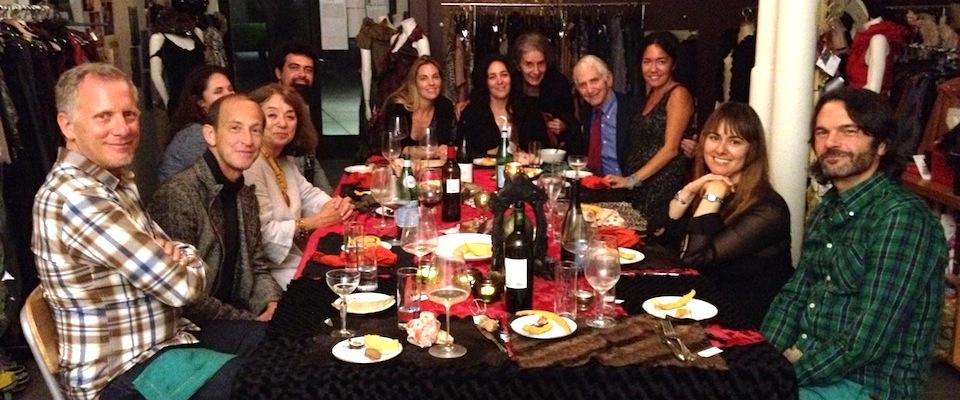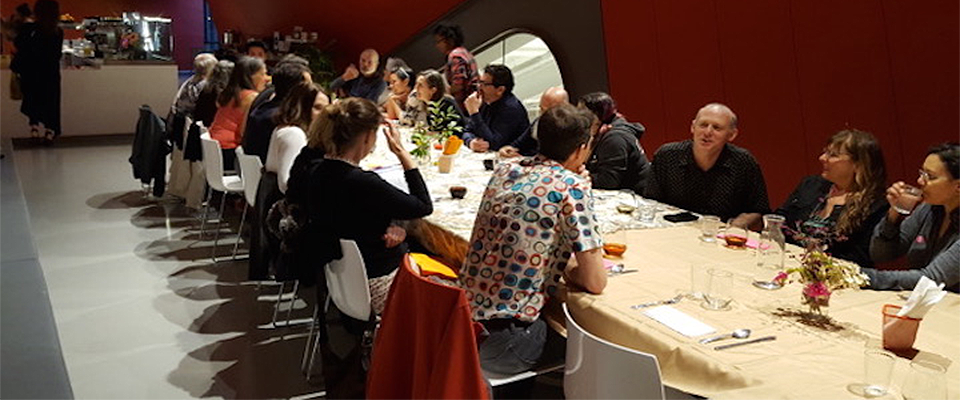Racks of gowns, manikins, and sewing machines crowd the edges of Cari Borja’s design studio, but a huge dining table occupies the center. It’s where she holds the dinners that resemble the fieldwork of an anthropologist outside the Ivory Tower. For a series of 52 meals—44 already served—she has transformed her studio into a salon where guests, from the famous to the unknown, discover connections and savor a slow meal.
She has hosted Daniel Ellsberg, Michael Pollan, Alice Waters, and other prominent writers, chefs, and academics, but the guest list is just as likely to include old friends, acquaintances, or the German graduate student who wandered in one day and asked if Borja could make him a computer case.
“It’s about introducing and weaving people together,” she says, sitting in the studio on Berkeley’s Fourth Street, wearing a simple black dress and tan boots.
Borja blogs about the project and intends at its conclusion to put together a “cultural ethnography of the Bay Area” that will document her guests’ lives and the worlds they bring with them to the table. It’s not so far from the study of humankind she carried out as a graduate student in cultural anthropology at UC Berkeley, where she received her doctorate in 2001.
“She is an anthropologist through and through,” says Laura Nader, a Berkeley anthropology professor who met Borja at Cal and is now a friend, dinner guest, and client. (When Nader’s daughter wed, Borja made both the wedding dress and Nader’s gown for the event.) “Most people find a specialty and stick with it the rest of their lives. She is not stuck in the mud.”

So how did Borja go from studying anthropology to creating clothes and then curating dinners? As with most things in her life, not in a straight line.
“I have one friend who says I’m like a comet,” she says, a description that would fit if comets made connections between unlikely destinations.
Borja grew up in Massachusetts an only child, raised by a single mother who worked hard to support her. She loved to roller skate, and her mother sewed her elaborate costumes for competitions. Those outfits, brightly colored and often detailed in sequins or ruffles, gave her a sense of the power of fashion, she says.
In college she studied art history and economics and spent her junior year in London. It was an eye-opening time for her, allowing her to travel in Europe, visit museums, and observe different cultures. After graduation, she veered toward what most intrigued her. (“I thought I’d be an investment banker,” she says. “But obviously I’m not.”) She worked as an intern at the Museum of Modern Art in New York and, on a fellowship, at the Guggenheim. Another grant enabled her to spend three months at the Peggy Guggenheim Collection in Venice.
She realized, she says, that what most interested her was anthropology, specifically the relationship between identity and place. Her introduction to the discipline came at the School of Oriental and African Studies in London, where she earned a master’s degree. From there she went to Berkeley. It was her first trip to California.
“At first I thought it was provincial here, going from London to Telegraph Avenue, then to Kroeber Hall,” where the anthropology department is housed, she says. “But I loved the minds there.”
She studied film and anthropology, writing her dissertation on the Jamaican art world and the relationship of people to art objects, a project that required research trips to the Caribbean.
It still surprises her, she says, how one set of experiences leads to something totally unexpected. She came into contact with people because she traveled, or just because of where she happened to be. She met her husband, Lloyd Bernberg, who works in film, because their windows faced each other. When someone called the police to complain about a cocktail party at her home, she went over to confront Bernberg. Turns out he hadn’t been the one who called. Wrong neighbor, right partner. They have now been married 14 years and have two children, ages 11 and 8.
On a trip to Italy shortly after their marriage, they visited Li Galli, known as the Islands of Sirens, off the Amalfi Coast—and moved by the islands’ beauty and history, Borja decided she wanted to make clothes for the sirens. When she returned home she began buying patterns and thinking like an architect about how garments were constructed. That led her to buy clothes at vintage stores and take them apart, teaching herself to sew.
With no formal training, she avoided buttonholes and zippers, finding ways to work with fabric by cutting on the bias, building ruffles and sculptural detail that was elegant but not fussy. She drew inspiration from old movies that featured gowns with flowing, graceful lines.
Designing and making clothes especially suited her when she started a family and could keep her young children with her at the studio. She even added a children’s line for them. But clothing also piqued her interest as an anthropologist—the interplay of stories and fabrics and relationships.
Working in her studio, sometimes with a few assistants, she sold to women of all sizes, to academics, actresses, and moms. She didn’t advertise, but her creations began to show up in magazine shoots and trunk shows. Despite not attending a fashion school, she taught a class at the Fashion Institute of Design & Merchandising in San Francisco.
She credits her husband with fueling her interest in cooking, particularly in the slow food movement. Two years ago, she signed on for a 12-week prep cooking stint at Chez Panisse in Berkeley, and then held her 40th birthday party at the famed restaurant founded by Alice Waters.
She even created a collection of gowns inspired by the brilliantly colored beets, carrots, and asparagus served there.

“She has a very whimsical side,” said Waters, a friend, dinner guest, and client—though she doesn’t own any of the vegetable-inspired creations.
A few years ago Borja began holding dinners as a way to create more links between people. There was only so far a dialog in clothes could take her. With food, she says, the possibilities were greater.
Some of her early dinners had color themes—red (risotto, velvet cake), blue (the gown she wore, blueberry crumble), and green (peas and asparagus). Others were more esoteric.
With the studio as backdrop—a museum-like space filled with clothes, keepsake wine bottles, photos, and small, curated collections of mementos—a few dozen guests meet and talk. The food is as varied as the guests; she has served her mother’s recipes and collaborated on dishes from other cultures. Guests bring wine and dessert.
Borja has begun posting interviews with some of her guests that dig into questions, once again, of identity and space, what she calls personal “terroir.” She also plans to teach an anthropology class at Berkeley next year, and to continue designing gowns.
“We live in a town full of interesting people, most of whom don’t know each other,” said Nader. “She is addressing the idea of ’The Lonely Crowd’ that [David] Riesman talked about in the 1950s. It’s amazing. She is making a contribution to the social atmosphere on top of her exotic beautiful clothes.”





















